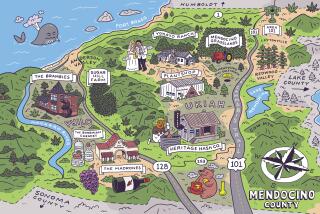Napa Is Finding Its Image Spread Thin
NAPA, Calif — Silhouetted against a cloud-streaked sky, the Grapecrusher, a super-sized statue of a laborer wrestling with an old wine press, marks the southern entrance to the Napa Valley and its famous fine wines.
But the valley has made a name for itself that goes far beyond vineyards and the robust cabernets and mellow chardonnays they produce. These days everything from pizza to perfume is being pitched under the Napa tent.
However, the blooming of brand Napa presents a bit of a dilemma for valley vintners. As their small wine-growing region has become shorthand for quality -- a triumph of good taste and good marketing -- there are concerns about the plethora of other products using the Napa label.
“There are two basic goals: One is to market Napa Valley, and the other is to protect it,” said Clay Gregory, president of the Napa Valley Vintners Assn.
Thus, the group is fighting to make it illegal to sell non-Napa wine under the Napa label.
“We don’t want people to think that Napa is a broad- based commodity,” said Gregory, pointing out that the valley accounts for only 4% of California’s total wine production. “We want folks to understand that it’s a very special place to grow wine grapes.”
A watershed for Napa Valley was the famous Paris taste test of 1976, organized by wine connoisseur Steven Spurrier, in which California wines beat some of France’s top vintages.
It was around that time that valley vintners began marketing themselves collectively.
Nowadays, consumers recognize that a wine from Napa Valley is a safe bet.
But don’t bet that all wines with Napa on the label are from Napa Valley.
Federal regulations dictate that if a wine label refers to a specific region, then at least 75% of the grapes in the wine must come from that region, but the rules make an exception for brands established before 1986.
One such brand is Napa Ridge, made by Bronco Wine Co. of Central California.
Astute wine drinkers can tell a wine’s origin by reading the fine print. A government regulation requires that if a bottle carries an official American Viticultural Area designation, then at least 85% of the wine must come from the region named.
So if a wine is labeled California, that means most of the grapes came from anywhere in the state; if it’s labeled Napa Valley, then at least 85% of the grapes hailed from there. At the highest end, the grapes are sourced to smaller regions such as Wild Horse Valley, a subset of the Napa Valley.
Still, label reading is a bit of an art, and the vintners association argues that many may miss the distinction.
About two years ago, California lawmakers closed the pre- 1986 loophole, but that law was struck down last year after being challenged by Bronco. The California Supreme Court recently agreed to hear the vintners’ appeal, which could happen in about a year.
In all, more than 30 wine names were grandfathered in under the federal exception, said Gregory, who worries about a potential wave of Napa knockoffs.
But Bronco publicist Harvey Posert said valley vintners were trying to impose an unreasonable rule in a world in which names based on geographical regions -- sherry, port -- often pass into the common vernacular.
“The consumer, we believe, understands that all burgundy doesn’t come from Burgundy,” he said. “The position of Bronco is once the international world gets straight on this, then it’s something to discuss.”
Napa’s name is being used for more than wine. There’s Napa Valley soda, Flora Napa Valley perfume and Napa Knobs, a high-end hardware business on the Internet.
Also grabbing a slice of the action is Napa Pizza, a new product from the Round Table chain.
Jack Stuart, wine master and general manager of Silverado Vineyards, winces at the idea of hawking pepperoni pizza under the Napa name. He likes the cheeky humor of Round Table’s TV spots -- one shows the chain’s sturdy spokesman enjoying a pizza during a wine tasting -- but Stuart’s not crazy about the trend they represent.
“All of these things risk diminishing the value of the name for wine,” he said, “and that’s really where the value came from.”
More to Read
Eat your way across L.A.
Get our weekly Tasting Notes newsletter for reviews, news and more.
You may occasionally receive promotional content from the Los Angeles Times.








